Using Artificial Neural Network Algorithm and Remote Sensing Vegetation Index Improves the Accuracy of the Penman-Monteith Equation to Estimate Cropland Evapotranspiration
Abstract
:1. Introduction
2. Material and Methods
2.1. Material
2.2. Two ET Models Based on ANN
2.2.1. ANN-PM Model
2.2.2. Medlyn-PM Model
2.3. ANN Architecture Optimization
2.4. Model Evaluation
2.4.1. Model Performance Measurement
2.4.2. Evaluating the Model Used to Estimate ET under Dry Climate
3. Results
3.1. Model Parameter Optimization
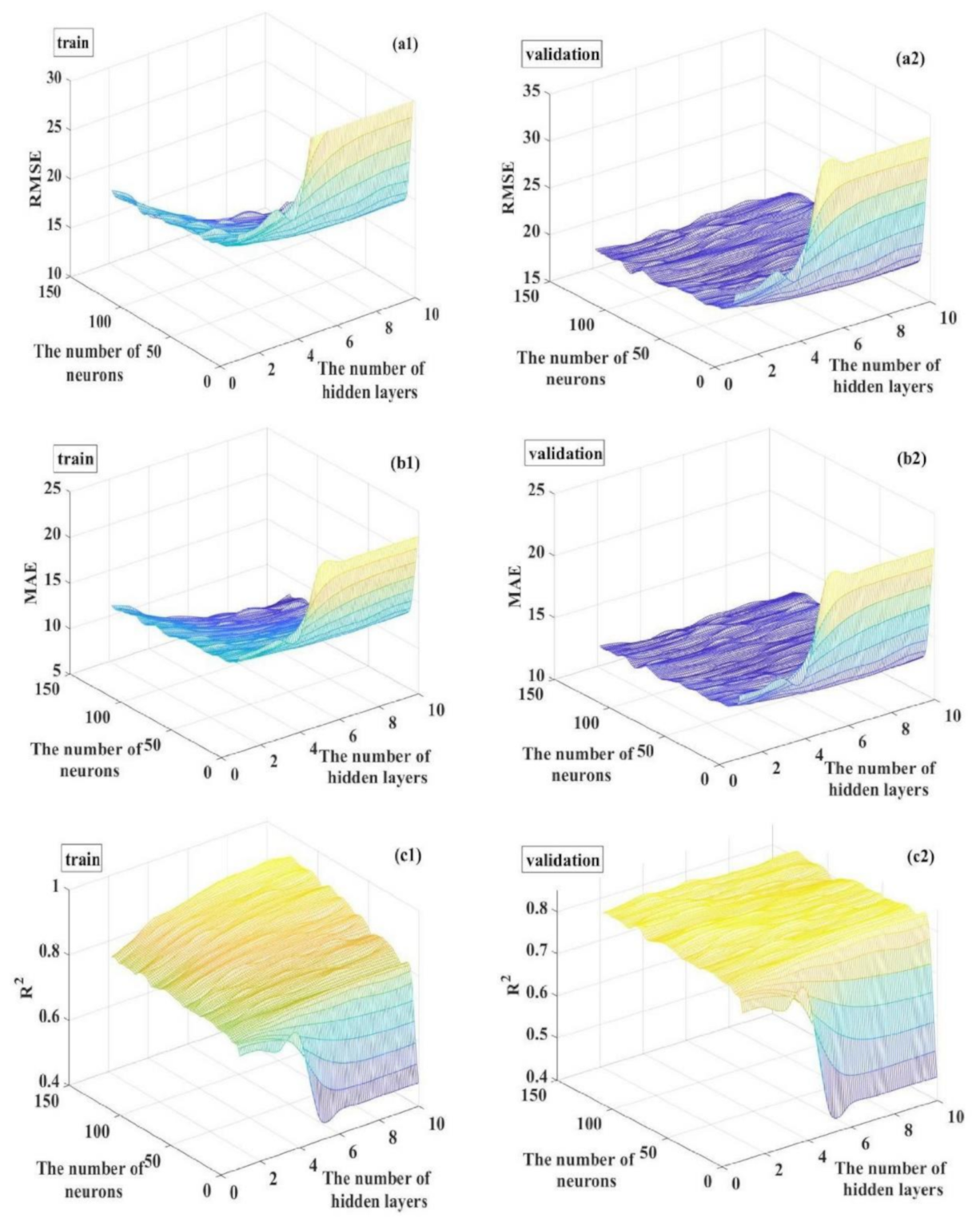
3.2. Comparison of ANN Model with Different Input Data
3.3. Comparison of ANN-PM and Medlyn-PM
3.4. Accuracy of ANN-PM Model under Dry Climates
4. Discussion
4.1. Discussion of the Number of Sites
4.2. Comparison between this Research and Existing Research
4.3. Comparison of the ANN-Based ET Model with Existing ML-Based ET Models
4.4. The Reasons for the Low Accuracy of the Medlyn-PM Model and the Lack of the ANN-PM Model
5. Conclusions
- The optimal ANN architecture to estimate Gs in ANN-PM consists of two hidden layers with 48 neurons in each layer, and that to estimate GPP in Medlyn-PM, two hidden layers and one neuron in each layer was optimal. The optimized g0 and g1 values in Medlyn’s Gs model are 0.06 and 3.94, respectively.
- The ANN-PM model can reasonably estimate the ET of cropland (RMSE = 19.09–19.50 W m−2, MAE = 13.27–13.41 W m−2, and R2 = 0.83 for training, validation, and test datasets) and is proven to perform better than Medlyn-PM with a smaller RMSE and MAE and larger R2.
- The ANN approach can represent the water stress impacts on ET well, as ANN-PM can reasonably capture the seasonal variations in ET at the dry sties (AI < 0.5). Additionally, the performances of the ANN-PM model at the dry sites were as good as at the wet sites.
Author Contributions
Funding
Institutional Review Board Statement
Informed Consent Statement
Data Availability Statement
Acknowledgments
Conflicts of Interest
References
- Sepaskhah, A.R.; Ilampour, S. Effects of soil moisture stress on evapotranspiration partitioning. Agric. Water Manag. 1995, 28, 311–323. [Google Scholar] [CrossRef]
- Jasechko, S.; Sharp, Z.D.; Gibson, J.J.; Birks, S.J.; Yi, Y.; Fawcett, P.J. Terrestrial water fluxes dominated by transpiration. Nature 2013, 496, 347–350. [Google Scholar] [CrossRef]
- Ding, J.; Peng, S.; Xu, J.; Wei, Z. Evapotranspiration model of water-saving irrigated paddy field based on penman Monteith equation. J. Agric. Eng. 2010, 26, 31–35. [Google Scholar]
- Liu, S.; Liu, Z. Estimation of crop evapotranspiration by Priestley Taylor formula. Plateau Meteorol. 1997, 80–85. [Google Scholar]
- Cleugh, H.A.; Leuning, R.; Mu, Q.Z.; Running, S.W. Regional evaporation estimates from flux tower and MODIS satellite data. Remote Sens. Environ. 2007, 106, 285–304. [Google Scholar] [CrossRef]
- Mu, Q.; Heinsch, F.A.; Zhao, M.; Running, S.W. Development of a global evapotranspiration algorithm based on MODIS and global meteorology data. Remote Sens. Environ. 2007, 111, 519–536. [Google Scholar] [CrossRef]
- Mu, Q.; Zhao, M.; Running, S.W. Improvements to a MODIS global terrestrial evapotranspiration algorithm. Remote Sens. Environ. 2011, 115, 1781–1800. [Google Scholar] [CrossRef]
- Leuning, R.; Zhang, Y.Q.; Rajaud, A.; Cleugh, H.; Tu, K. A simple surface conductance model to estimate regional evaporation using MODIS leaf area index and the Penman-Monteith equation. Water Resour. Res. 2008, 44, 17. [Google Scholar] [CrossRef]
- Zhang, Y.; Leuning, R.; Hutley, L.B.; Beringer, J.; McHugh, I.; Walker, J.P. Using long-term water balances to parameterize surface conductances and calculate evaporation at 0.05° spatial resolution. Water Resour. Res. 2010, 46. [Google Scholar] [CrossRef] [Green Version]
- Yebra, M.; Van Dijk, A.; Leuning, R.; Huete, A.; Guerschman, J.P. Evaluation of optical remote sensing to estimate actual evapotranspiration and canopy conductance. Remote Sens. Environ. 2013, 129, 250–261. [Google Scholar] [CrossRef]
- Kitao, M.; Komatsu, M.; Hoshika, Y.; Yazaki, K.; Yoshimura, K.; Fujii, S.; Miyama, T.; Kominami, Y. Seasonal ozone uptake by a warm-temperate mixed deciduous and evergreen broadleaf forest in western Japan estimated by the Penman-Monteith approach combined with a photosynthesis-dependent stomatal model. Environ. Pollut. 2014, 184, 457–463. [Google Scholar] [CrossRef] [Green Version]
- Ball, J.T.; Woodrow, I.E.; Berry, J.A. A model predicting stomatal conductance and its contribution to the control of photosynthesis under different environmental conditions. In Progress in Photosynthesis Research; Springer: Dordrecht, The Netherlands, 1987; pp. 221–224. ISBN 978-94-017-0521-9. [Google Scholar]
- Yan, H.; Wang, S.Q.; Billesbach, D.; Oechel, W.; Zhang, J.H.; Meyers, T.; Martin, T.A.; Matamala, R.; Baldocchi, D.; Bohrer, G.; et al. Global estimation of evapotranspiration using a leaf area index-based surface energy and water balance model. Remote Sens. Environ. 2012, 124, 581–595. [Google Scholar] [CrossRef] [Green Version]
- Mallick, K.; Trebs, I.; Boegh, E.; Giustarini, L.; Schlerf, M.; Drewry, D.T.; Hoffmann, L.; von Randow, C.; Kruijt, B.; Araùjo, A.; et al. Canopy-scale biophysical controls of transpiration and evaporation in the Amazon Basin. Hydrol. Earth Syst. Sci. 2016, 20, 4237–4264. [Google Scholar] [CrossRef] [Green Version]
- Bhattarai, N.; Mallick, K.; Stuart, J.; Vishwakarma, B.D.; Niraula, R.; Sen, S.; Jain, M. An automated multi-model evapotranspiration mapping framework using remotely sensed and reanalysis data. Remote Sens. Environ. 2019, 229, 69–92. [Google Scholar] [CrossRef]
- Jung, M.; Reichstein, M.; Bondeau, A. Towards global empirical upscaling of FLUXNET eddy covariance observations: Validation of a model tree ensemble approach using a biosphere model. Biogeosciences 2009, 6, 2001–2013. [Google Scholar] [CrossRef] [Green Version]
- Traore, S.; Wang, Y.-M.; Kerh, T. Artificial neural network for modeling reference evapotranspiration complex process in Sudano-Sahelian zone. Agric. Water Manag. 2010, 97, 707–714. [Google Scholar] [CrossRef]
- Zhang, W.; Huo, S.; Jia, Y. Comparison of machine learning models in the calculation of reference crop evapotranspiration in Hebei Province. Water Sav. Irrig. 2018, 4, 50–58. [Google Scholar]
- Zhao, W.L.; Gentine, P.; Reichstein, M.; Zhang, Y.; Zhou, S.; Wen, Y.; Lin, C.; Li, X.; Qiu, G.Y. Physics-constrained machine learning of evapotranspiration. Geophys. Res. Lett. 2019, 46, 14496–14507. [Google Scholar] [CrossRef]
- Du, K.L.; Swamy, M. Neural Networks and Statistical Learning; Springer: London, UK, 2014. [Google Scholar]
- Bai, Y.; Zhang, S.; Bhattarai, N.; Mallick, K.; Liu, Q.; Tang, L.; Im, J.; Guo, L.; Zhang, J. On the use of machine learning based ensemble approaches to improve evapotranspiration estimates from croplands across a wide environmental gradient. Agric. For. Meteorol. 2021, 298–299, 108308. [Google Scholar] [CrossRef]
- Tabari, H.; Talaee, P.H. Local calibration of the Hargreaves and Priestley-Taylor equations for estimating reference evapotranspiration in arid and cold climates of iran based on the penman-monteith model. J. Hydrol. Eng. 2011, 16, 837–845. [Google Scholar] [CrossRef]
- Yang, Z.; Zhang, Q.; Yang, Y.; Hao, X.; Zhang, H. Evaluation of evapotranspiration models over semi-arid and semi-humid areas of China. Hydrol. Process. 2016, 30, 4292–4313. [Google Scholar] [CrossRef]
- Muhammad, M.; Nashwan, M.; Shahid, S.; Ismail, T.; Song, Y.; Chung, E.-S. Evaluation of empirical reference evapotranspiration models using compromise programming: A case study of Peninsular Malaysia. Sustainability 2019, 11, 4267. [Google Scholar] [CrossRef] [Green Version]
- Peng, L.; Zeng, Z.; Wei, Z.; Chen, A.; Wood, E.F.; Sheffield, J. Determinants of the ratio of actual to potential evapotranspiration. Glob. Chang. Biol. 2019, 25, 1326–1343. [Google Scholar] [CrossRef] [Green Version]
- Liu, M.; Tang, R.; Li, Z.-L.; Yao, Y.; Yan, G. Global land surface evapotranspiration estimation from meteorological and satellite data using the support vector machine and semiempirical algorithm. IEEE J. Sel. Top. Appl. Earth Obs. Remote Sens. 2018, 11, 513–521. [Google Scholar] [CrossRef]
- Tang, D.; Feng, Y.; Gong, D.; Hao, W.; Cui, N. Evaluation of artificial intelligence models for actual crop evapotranspiration modeling in mulched and non-mulched maize croplands. Comput. Electron. Agric. 2018, 152, 375–384. [Google Scholar] [CrossRef]
- Adnan, R.M.; Malik, A.; Kumar, A.; Parmar, K.S.; Kisi, O. Pan evaporation modeling by three different neuro-fuzzy intelligent systems using climatic inputs. Arab. J. Geosci. 2019, 12, 1–14. [Google Scholar] [CrossRef]
- Reis, M.M.; da Silva, A.J.; Zullo Junior, J.; Tuffi Santos, L.D.; Azevedo, A.M.; Lopes, É.M.G. Empirical and learning machine approaches to estimating reference evapotranspiration based on temperature data. Comput. Electron. Agric. 2019, 165, 104937. [Google Scholar] [CrossRef]
- Granata, F.; Gargano, R.; de Marinis, G. Artificial intelligence based approaches to evaluate actual evapotranspiration in wetlands. Sci. Total Environ. 2020, 703, 135653. [Google Scholar] [CrossRef]
- Zhu, B.; Feng, Y.; Gong, D.; Jiang, S.; Zhao, L.; Cui, N. Hybrid particle swarm optimization with extreme learning machine for daily reference evapotranspiration prediction from limited climatic data. Comput. Electron. Agric. 2020, 173, 105430. [Google Scholar] [CrossRef]
- Reichstein, M.; Camps-Valls, G.; Stevens, B.; Jung, M.; Denzler, J.; Carvalhais, N. Deep learning and process understanding for data-driven Earth system science. Nature 2019, 566, 195–204. [Google Scholar] [CrossRef] [PubMed]
- Chen, Y.; Xia, J.; Liang, S.; Feng, J.; Fisher, J.B.; Li, X.; Li, X.; Liu, S.; Ma, Z.; Miyata, A.; et al. Comparison of satellite-based evapotranspiration models over terrestrial ecosystems in China. Remote Sens. Environ. 2014, 140, 279–293. [Google Scholar] [CrossRef]
- Badgley, G.; Anderegg, L.D.L.; Berry, J.A.; Field, C.B. Terrestrial gross primary production: Using NIRV to scale from site to globe. Glob. Chang. Biol. 2019, 25, 3731–3740. [Google Scholar] [CrossRef] [PubMed]
- Moureaux, C.; Debacq, A.; Bodson, B.; Heinesch, B.; Aubinet, M. Annual net ecosystem carbon exchange by a sugar beet crop. Agric. For. Meteorol. 2006, 139, 25–39. [Google Scholar] [CrossRef]
- Moors, E.; Jacobs, C.; Jans, W.; Supit, I.; Kutsch, W.; Bernhofer, C.; Beziat, P.; Buchmann, N.; Carrara, A.; Ceschia, E.; et al. Variability in carbon exchange of European croplands. Agric. Ecosyst. Environ. 2010, 139, 325–335. [Google Scholar] [CrossRef]
- Anthoni, P.M.; Knohl, A.; Rebmann, C.; Freibauer, A.; Mund, M.; Ziegler, W.; Kolle, O.; Schulze, E.D. Forest and agricultural land-use-dependent CO2 exchange in Thuringia, Germany. Glob. Chang. Biol. 2004, 10, 2005–2019. [Google Scholar] [CrossRef]
- Brust, K.; Hehn, M.; Bernhofer, C. Comparative analysis of matter and energy fluxes determined by Bowen Ratio and Eddy Covariance techniques at a crop site in eastern Germany. In Proceedings of the European Geosciences Union General Assembly, Vienna, Austria, 22–27 April 2012; p. 8006. [Google Scholar]
- Eder, F.; Schmidt, M.; Damian, T.; Träumner, K.; Mauder, M. Mesoscale eddies affect near-surface turbulent exchange: Evidence from lidar and tower measurements. J. Appl. Meteorol. Climatol. 2015, 54, 189–206. [Google Scholar] [CrossRef] [Green Version]
- Korres, W.; Reichenau, T.G.; Schneider, K. Patterns and scaling properties of surface soil moisture in an agricultural landscape: An ecohydrological modeling study. J. Hydrol. 2013, 498, 89–102. [Google Scholar] [CrossRef] [Green Version]
- Loubet, B.; Laville, P.; Lehuger, S.; Larmanou, E.; Fléchard, C.; Mascher, N.; Genermont, S.; Roche, R.; Ferrara, R.M.; Stella, P.; et al. Carbon, nitrogen and Greenhouse gases budgets over a four years crop rotation in northern France. Plant Soil 2011, 343, 109–137. [Google Scholar] [CrossRef]
- Ranucci, S.; Bertolini, T.; Vitale, L.; Di Tommasi, P.; Ottaiano, L.; Oliva, M.; Amato, U.; Fierro, A.; Magliulo, V. The influence of management and environmental variables on soil N2O emissions in a crop system in Southern Italy. Plant Soil 2010, 343, 83–96. [Google Scholar] [CrossRef]
- Raz-Yaseef, N.; Billesbach, D.P.; Fischer, M.L.; Biraud, S.C.; Gunter, S.A.; Bradford, J.A.; Torn, M.S. Vulnerability of crops and native grasses to summer drying in the U.S. Southern Great Plains. Agric. Ecosyst. Environ. 2015, 213, 209–218. [Google Scholar] [CrossRef] [Green Version]
- Chu, H.; Chen, J.; Gottgens, J.F.; Ouyang, Z.; John, R.; Czajkowski, K.; Becker, R. Net ecosystem methane and carbon dioxide exchanges in a Lake Erie coastal marsh and a nearby cropland. J. Geophys. Res. Biogeosciences 2014, 119, 722–740. [Google Scholar] [CrossRef]
- Verma, S.B.; Dobermann, A.; Cassman, K.G.; Walters, D.T.; Knops, J.M.; Arkebauer, T.J.; Suyker, A.E.; Burba, G.G.; Amos, B.; Yang, H.; et al. Annual carbon dioxide exchange in irrigated and rainfed maize-based agroecosystems. Agric. For. Meteorol. 2005, 131, 77–96. [Google Scholar] [CrossRef] [Green Version]
- Suyker, A.E.; Verma, S.B. Gross primary production and ecosystem respiration of irrigated and rainfed maize-soybean cropping systems over 8 years. Agric. For. Meteorol. 2012, 165, 12–24. [Google Scholar] [CrossRef] [Green Version]
- Knox, S.H.; Sturtevant, C.; Matthes, J.H.; Koteen, L.; Verfaillie, J.; Baldocchi, D. Agricultural peatland restoration: Effects of land-use change on greenhouse gas (CO2 and CH4) fluxes in the Sacramento-San Joaquin Delta. Glob. Chang. Biol. 2015, 21, 750–765. [Google Scholar] [CrossRef]
- Baldocchi, D.; Sturtevant, C.; Contributors, F. Does day and night sampling reduce spurious correlation between canopy photosynthesis and ecosystem respiration? Agric. For. Meteorol. 2015, 207, 117–126. [Google Scholar] [CrossRef] [Green Version]
- Hatala, J.A.; Detto, M.; Baldocchi, D.D. Gross ecosystem photosynthesis causes a diurnal pattern in methane emission from rice. Geophys. Res. Lett. 2012, 39. [Google Scholar] [CrossRef] [Green Version]
- Jarvis, P.G. The interpretation of the variations in leaf water potential and stomatal conductance found in canopies in the field. Philos. Trans. R. Soc. B Biol. Sci. 1976, 273, 593–610. [Google Scholar]
- Matsumoto, K.; Ohta, T.; Nakai, T.; Kuwada, T.; Daikoku, K.i.; Iida, S.i.; Yabuki, H.; Kononov, A.V.; van der Molen, M.K.; Kodama, Y.; et al. Responses of surface conductance to forest environments in the Far East. Agric. For. Meteorol. 2008, 148, 1926–1940. [Google Scholar] [CrossRef]
- Medlyn, B.E.; Duursma, R.A.; Eamus, D.; Ellsworth, D.S.; Colin Prentice, I.; Barton, C.V.M.; Crous, K.Y.; de Angelis, P.; Freeman, M.; Wingate, L. Reconciling the optimal and empirical approaches to modelling stomatal conductance. Glob. Chang. Biol. 2012, 18, 3476. [Google Scholar] [CrossRef] [Green Version]
- Arifovic, J.; Gençay, R. Using genetic algorithms to select architecture of a feedforward artificial neural network. Phys. A Stat. Mech. Appl. 2001, 289, 574–594. [Google Scholar] [CrossRef]
- Jia, Z.; Liu, S.; Mao, D.; Wang, Z.; Xu, Z.; Zhang, R. Research on verification method of remote sensing monitoring evapotranspiration based on ground observation. Earth Sci. Prog. 2010, 25, 1248–1260. [Google Scholar]
- Fox, D.G. Judging air quality model performance: A summary of the ams workshop on dispersion model performance, woods hole, mass., 8–11 September 1980. Bull. Am. Meteorol. Soc. 1981, 62, 599–609. [Google Scholar] [CrossRef] [Green Version]
- UNESCO. Map of the World Distribution of Arid Regions; Explanatory Note; United Nations Educational, Scientific and Cultural Organization: Paris, France, 1979. [Google Scholar]
- Yin, L.; Tao, F.; Chen, Y.; Liu, F.; Hu, J. Improving terrestrial evapotranspiration estimation across China during 2000–2018 with machine learning methods. J. Hydrol. 2021, 600, 126538. [Google Scholar] [CrossRef]
- Kazemi, M.H.; Shiri, J.; Marti, P.; Majnooni-Heris, A. Assessing temporal data partitioning scenarios for estimating reference evapotranspiration with machine learning techniques in arid regions. J. Hydrol. 2020, 590, 125252. [Google Scholar] [CrossRef]
- Yamaç, S.S.; Todorovic, M. Estimation of daily potato crop evapotranspiration using three different machine learning algorithms and four scenarios of available meteorological data. Agric. Water Manag. 2020, 228, 105875. [Google Scholar] [CrossRef]
- He, M.; Kimball, J.S.; Yi, Y.; Running, S.W.; Guan, K.; Moreno, A.; Wu, X.; Maneta, M. Satellite data-driven modeling of field scale evapotranspiration in croplands using the MOD16 algorithm framework. Remote Sens. Environ. 2019, 230, 111201. [Google Scholar] [CrossRef]
- Amazirh, A.; Er-Raki, S.; Chehbouni, A.; Rivalland, V.; Diarra, A.; Khabba, S.; Ezzahar, J.; Merlin, O.J.B.E. Modified Penman–Monteith equation for monitoring evapotranspiration of wheat crop: Relationship between the surface resistance and remotely sensed stress index. Biosyst. Eng. 2017, 164, 68–84. [Google Scholar] [CrossRef]
- Feng, K.; Tian, J.; Hong, Y. Self-optimizing nearest neighbor algorithm to estimate potential evapotranspiration in limited meteorological data area. J. Agric. Eng. 2019, 35, 76–83. [Google Scholar]
- Abdullah, S.S.; Malek, M.A.; Abdullah, N.S.; Kisi, O.; Yap, K.S. Extreme Learning Machines: A new approach for prediction of reference evapotranspiration. J. Hydrol. 2015, 527, 184–195. [Google Scholar] [CrossRef]
- Antonopoulos, V.Z.; Antonopoulos, A.V. Daily reference evapotranspiration estimates by artificial neural networks technique and empirical equations using limited input climate variables. Comput. Electron. Agric. 2017, 132, 86–96. [Google Scholar] [CrossRef]
- Ferreira, L.B.; da Cunha, F.F. New approach to estimate daily reference evapotranspiration based on hourly temperature and relative humidity using machine learning and deep learning. Agric. Water Manag. 2020, 234. [Google Scholar] [CrossRef]
- Laaboudi, A.; Mouhouche, B.; Draoui, B. Neural network approach to reference evapotranspiration modeling from limited climatic data in arid regions. Int. J. Biometeorol. 2012, 56, 831–841. [Google Scholar] [CrossRef] [PubMed] [Green Version]
- Fan, J.; Yue, W.; Wu, L.; Zhang, F.; Cai, H.; Wang, X.; Lu, X.; Xiang, Y. Evaluation of SVM, ELM and four tree-based ensemble models for predicting daily reference evapotranspiration using limited meteorological data in different climates of China. Agric. For. Meteorol. 2018, 263, 225–241. [Google Scholar] [CrossRef]
- Yu, L.-P.; Huang, G.-H.; Liu, H.-J.; Wang, X.-P.; Wang, M.-Q. Experimental Investigation of Soil Evaporation and Evapotranspiration of Winter Wheat Under Sprinkler Irrigation. Agric. Sci. China 2009, 8, 1360–1368. [Google Scholar] [CrossRef]
- Liu, C.; Zhang, X.; Zhang, Y. Determination of daily evaporation and evapotranspiration of winter wheat and maize by large-scale weighing lysimeter and micro-lysimeter. Agric. For. Meteorol. 2002, 111, 109–120. [Google Scholar] [CrossRef]
- Qin, F.Y.; Jie, C.H.; Jian, W. Experiment of Soil Evaporation from Winter Wheat Field. Irrig. Drain. 2000, 19, 2–5. [Google Scholar]
- Wang, H.; Ma, M. Estimation of evapotranspiration from different ecosystems in inland river basins based on remote sensing and Penman-Monteith model. Acta Ecol. Sin. 2014, 34, 5617–5626. [Google Scholar]
- Yao, Y.; Cheng, J.; Zhao, S.; Jia, K.; Xie, X.; Sun, L. A review of research on farmland evapotranspiration estimation methods based on thermal infrared remote sensing. Earth Sci. Prog. 2012, 27, 1308–1318. [Google Scholar]
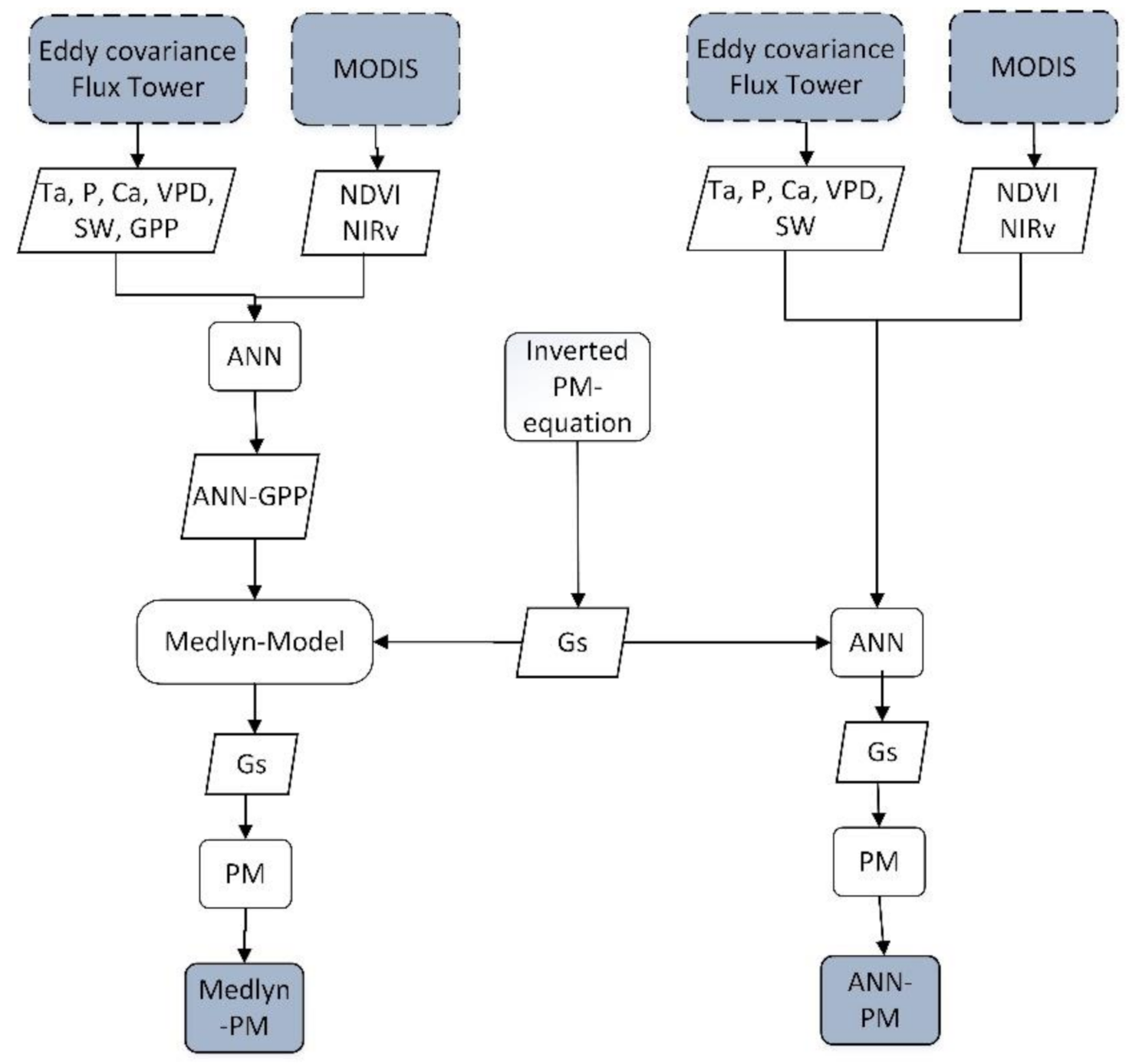
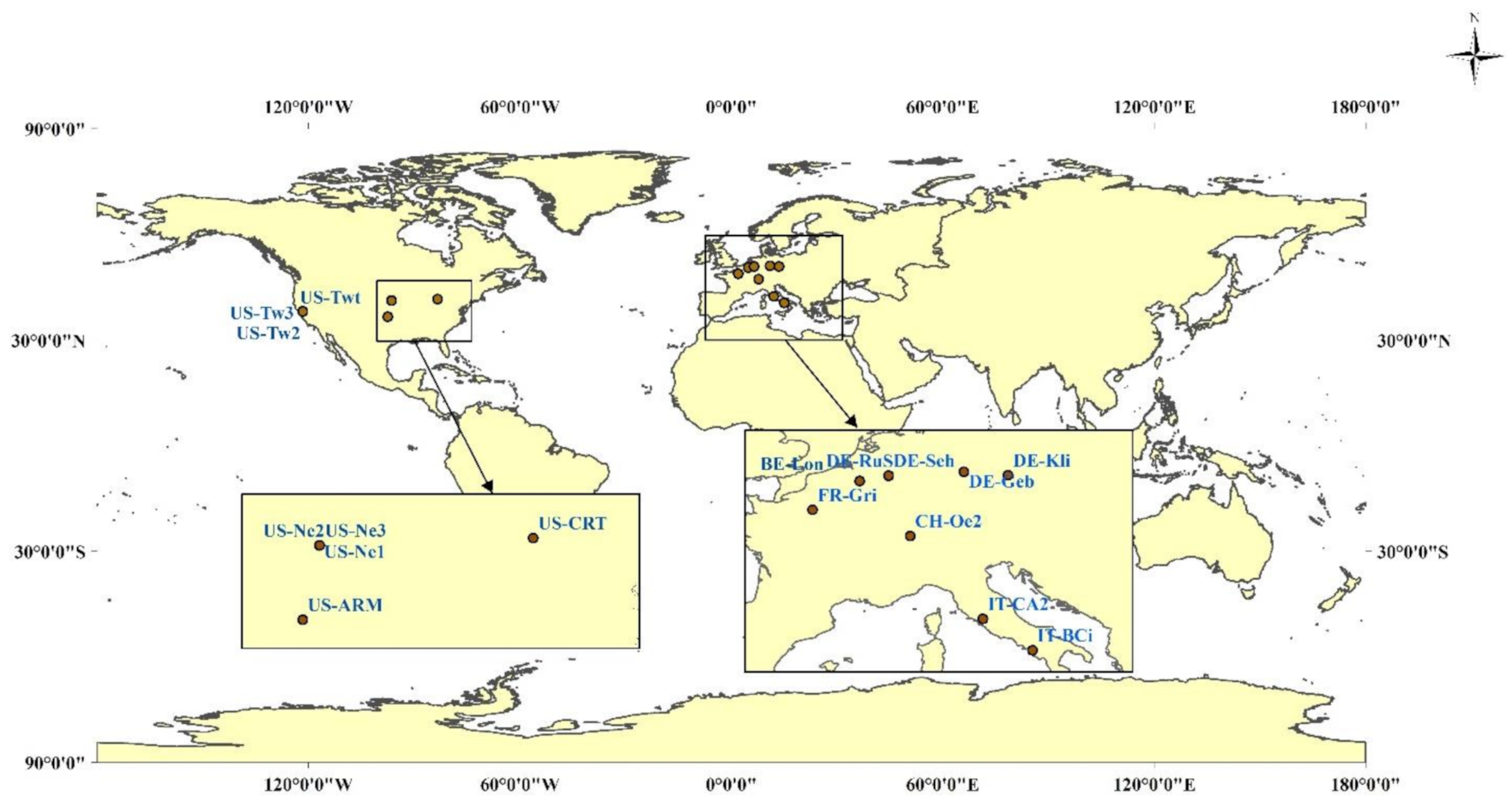
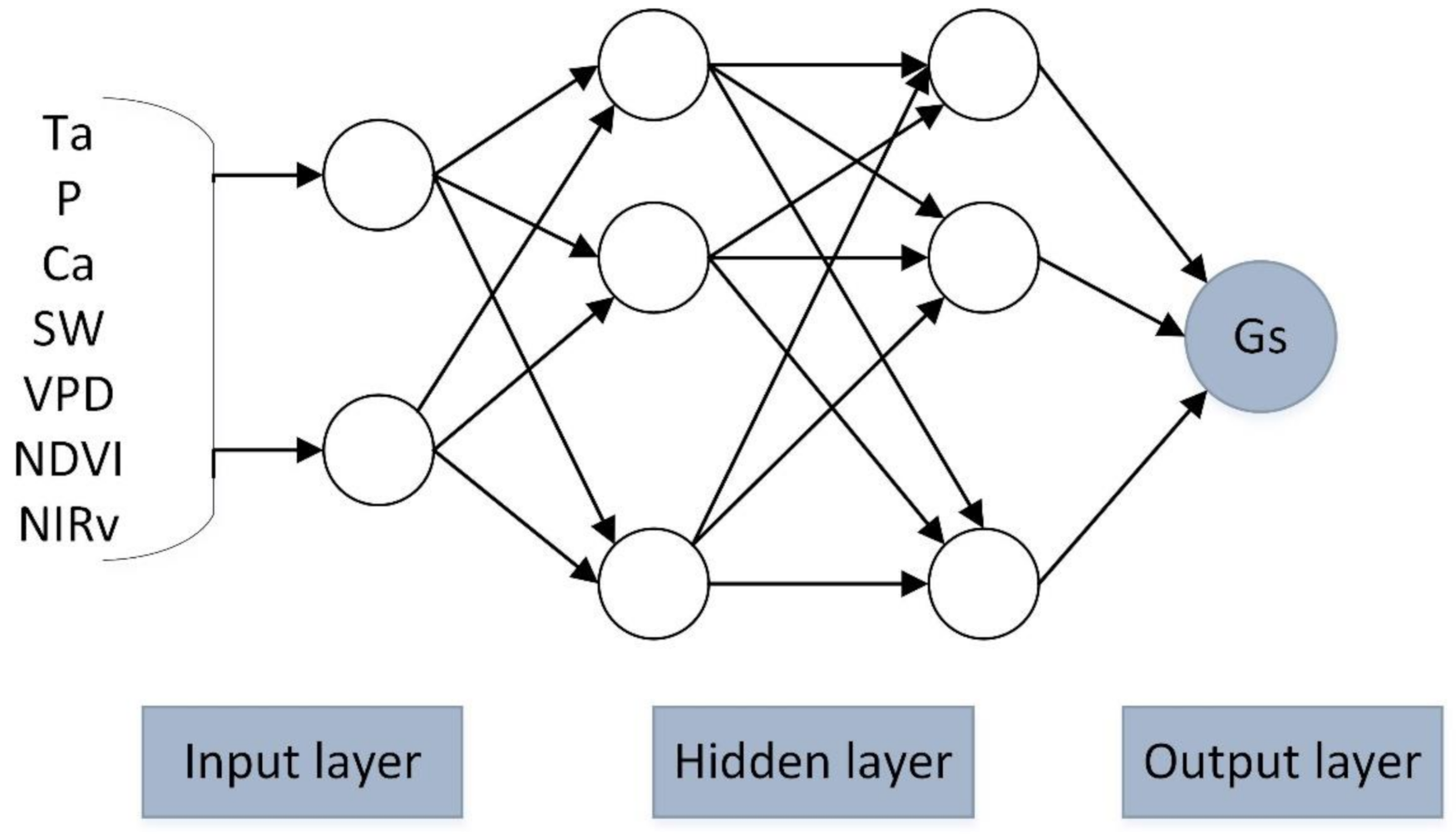
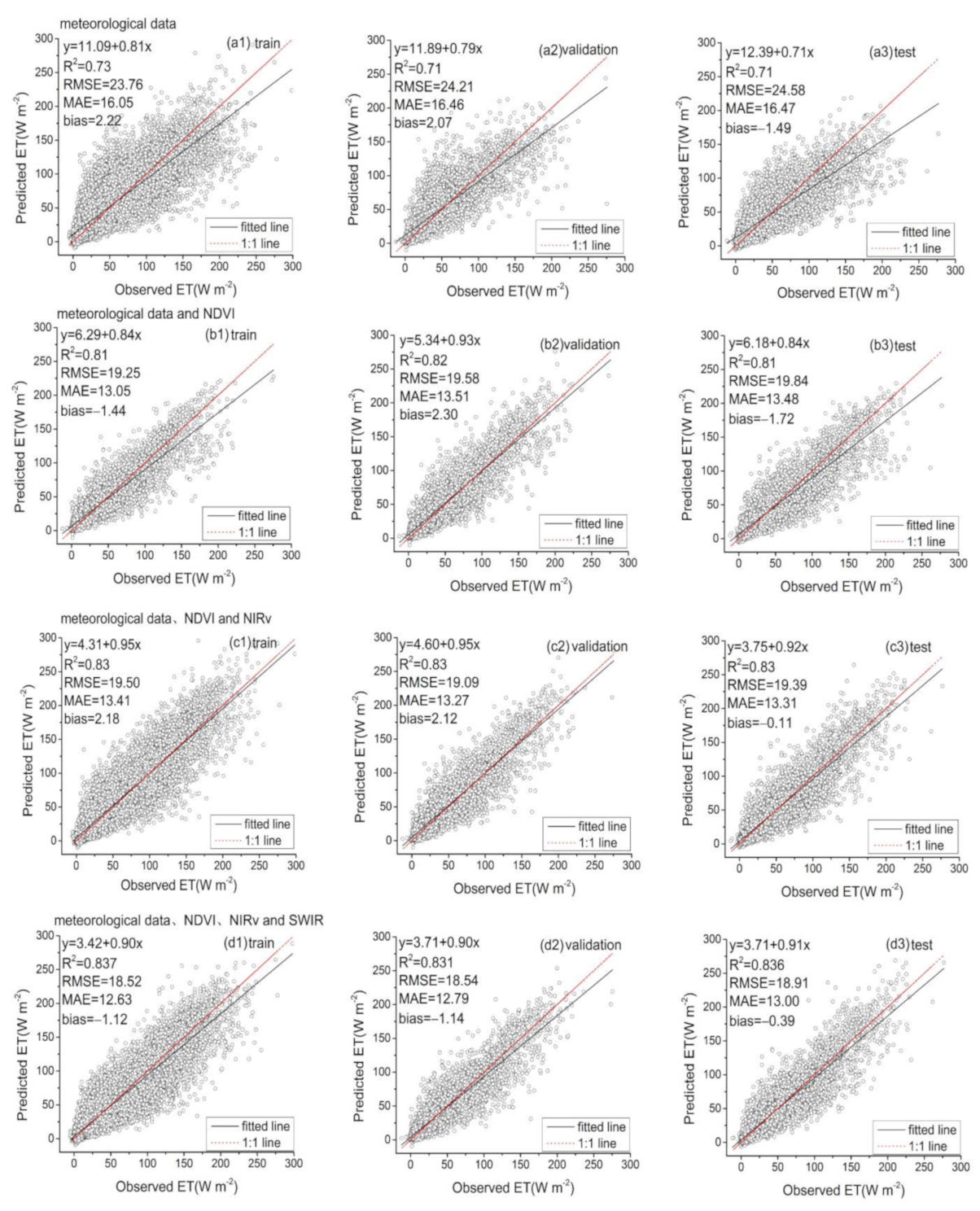
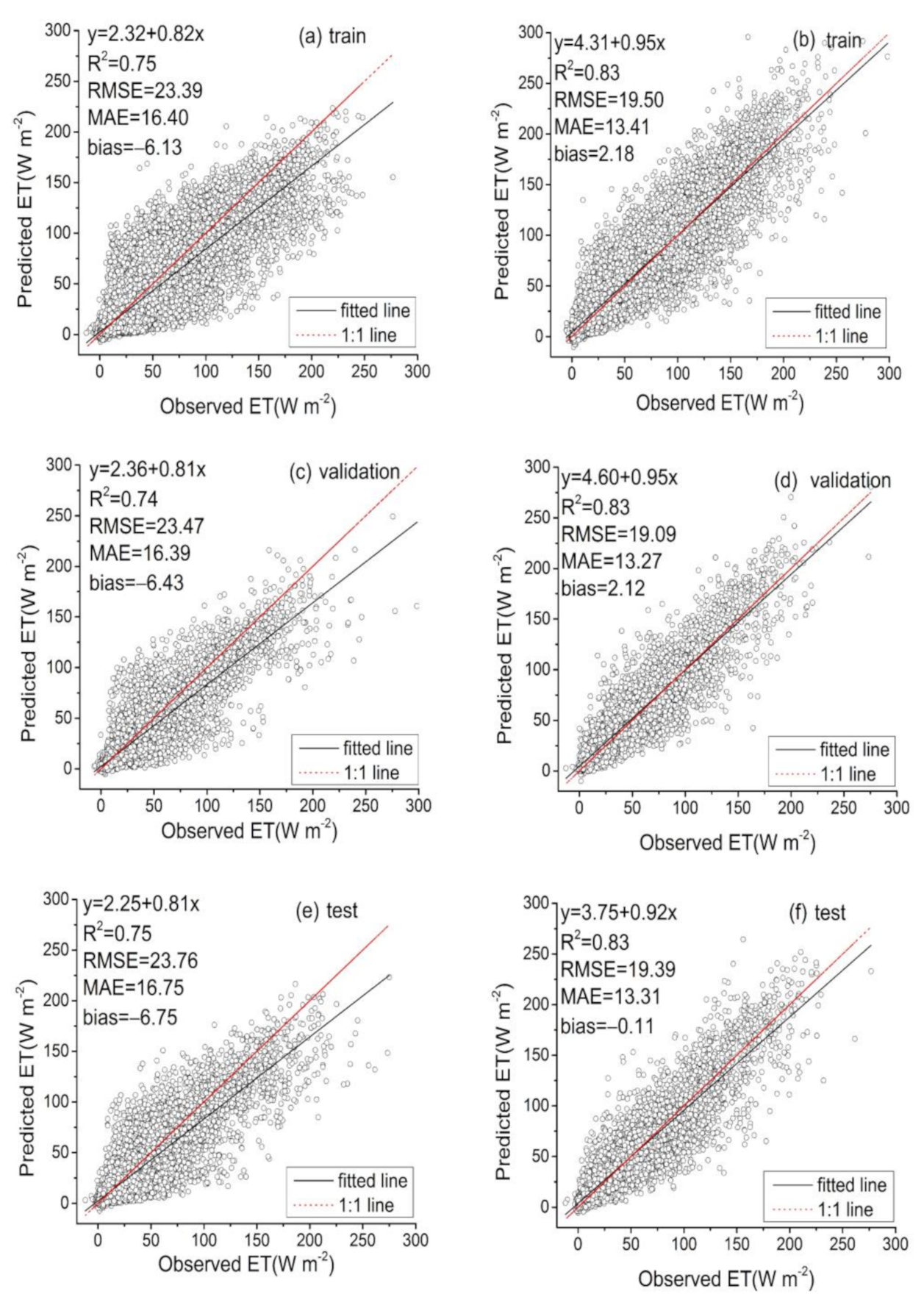
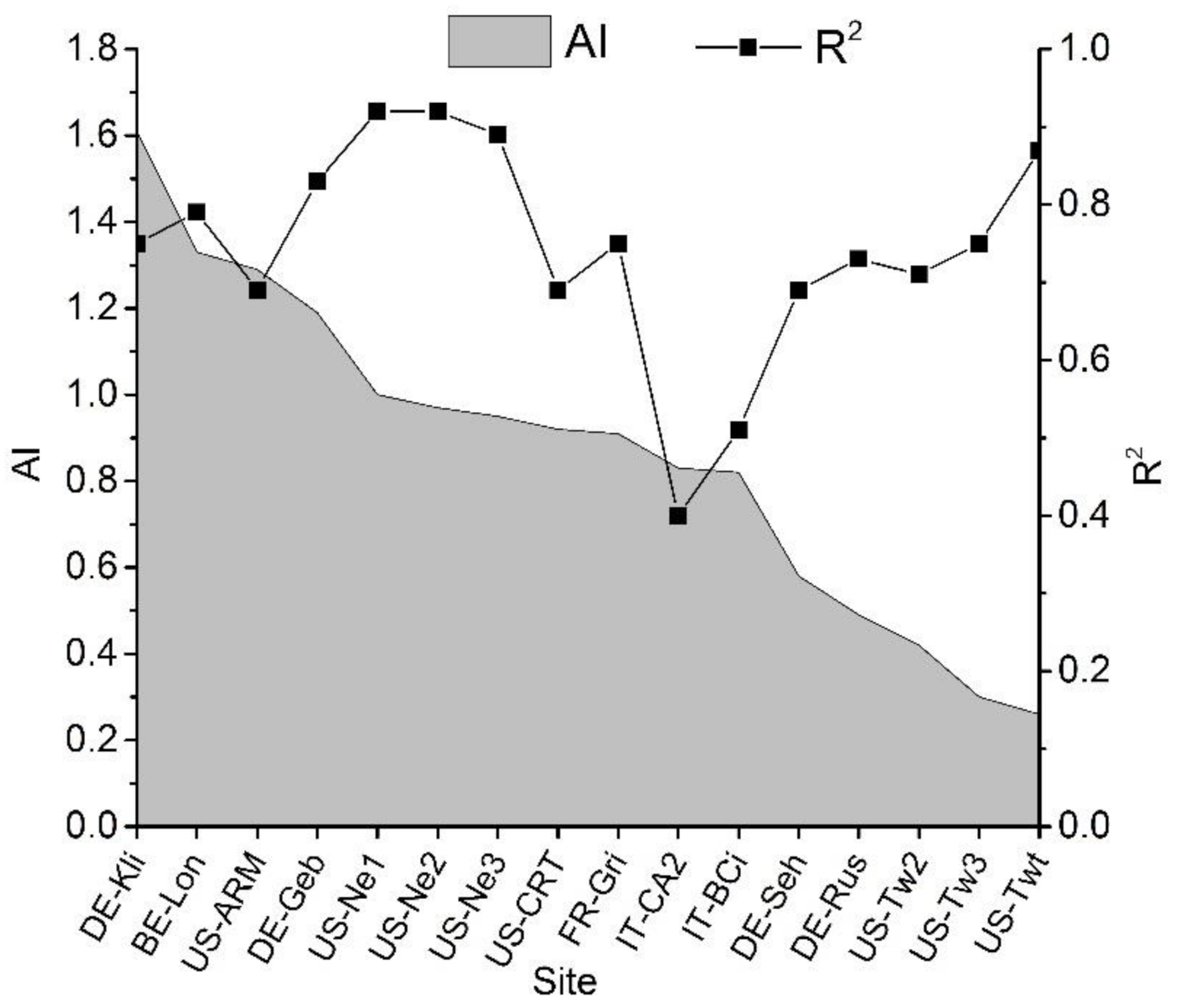
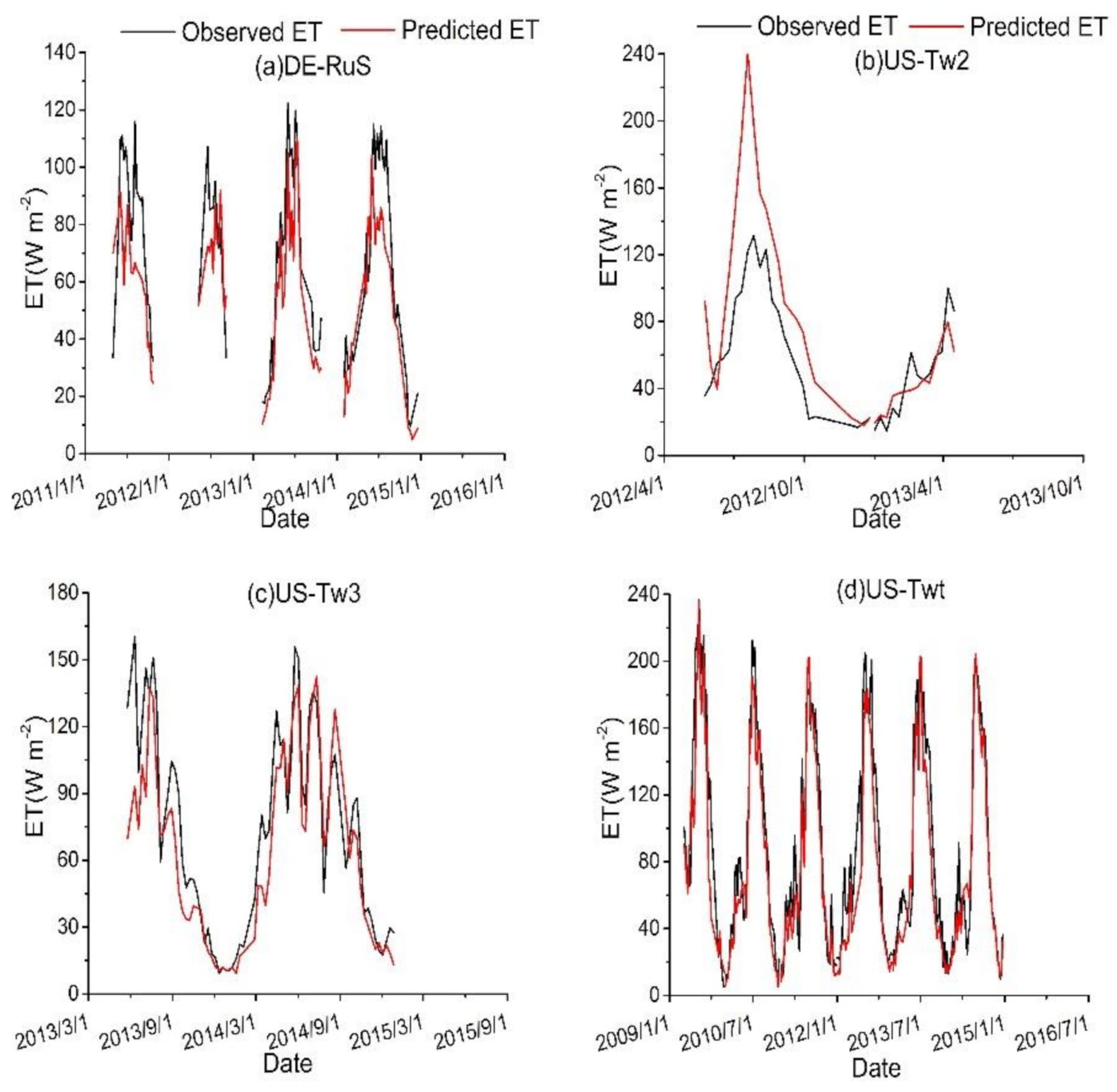
| Site Code | Latitude | Longitude | Mean Annual Temperature (°C) | Mean Annual Precipitation (mm) | Years | Reference |
|---|---|---|---|---|---|---|
| BE-Lon | 50.55 | 4.75 | 11.41 | 766.50 | 2004–2014 | Moureaux et al. [35] |
| CH-Oe2 | 47.29 | 7.73 | 9.56 | 2062.25 | 2004–2014 | Moors et al. [36] |
| DE-Geb | 51.10 | 10.91 | 9.67 | 532.90 | 2001–2014 | Anthoni et al. [37] |
| DE-Kli | 50.89 | 13.52 | 7.77 | 810.30 | 2004–2014 | Brust et al. [38] |
| DE-RuS | 50.86 | 6.45 | 10.80 | 551.15 | 2011–2014 | Eder et al. [39] |
| DE-Seh | 50.87 | 6.45 | 10.29 | 573.05 | 2007–2010 | Korres et al. [40] |
| FR-Gri | 48.84 | 1.95 | 10.96 | 598.60 | 2004–2014 | Loubet et al. [41] |
| IT-BCi | 40.52 | 14.96 | 17.88 | 1197.20 | 2004–2014 | Ranucci et al. [42] |
| IT-CA2 | 42.38 | 12.03 | 14.84 | 766.50 | 2011–2014 | |
| US-ARM | 36.60 | −97.49 | 15.27 | 646.05 | 2003–2012 | Raz-Yaseef et al. [43] |
| US-CRT | 41.63 | −83.35 | 10.85 | 810.30 | 2011–2013 | Chu et al. [44] |
| US-Ne1 | 41.1651 | −96.477 | 10.54 | 846.80 | 2001–2013 | Verma et al. [45] |
| US-Ne2 | 41.1649 | −96.470 | 10.26 | 876.00 | 2001–2013 | Suyker and Verma [46] |
| US-Ne3 | 41.1797 | −96.440 | 10.38 | 697.15 | 2001–2013 | Suyker and Verma [46] |
| US-Tw2 | 38.1047 | −121.643 | 15.23 | 386.90 | 2012–2013 | Knox et al. [47] |
| US-Tw3 | 38.1159 | −121.647 | 16.00 | 343.10 | 2013–2014 | Baldocchi et al. [48] |
| US-Twt | 38.1087 | −121.653 | 14.75 | 357.70 | 2009–2014 | Hatala et al. [49] |
| Index | Formula |
|---|---|
| NDVI | |
| NIRv |
| Number | Input Parameters |
|---|---|
| 1 | Ta, P, SW, Ca, VPD |
| 2 | Ta, P, SW, Ca, VPD, NDVI |
| 3 | Ta, P, SW, Ca, VPD, NDVI, NIRv |
| 4 | Ta, P, SW, Ca, VPD, NDVI, NIRv, SWIR |
| Evaluation Parameters | Formula |
|---|---|
| RMSE | |
| MAE | |
| R2 |
| ANN-PM Model | Medlyn-PM Model | |
|---|---|---|
| The number of hidden layers | 2 | 2 |
| The number of neurons | 48 | 1 |
Publisher’s Note: MDPI stays neutral with regard to jurisdictional claims in published maps and institutional affiliations. |
© 2021 by the authors. Licensee MDPI, Basel, Switzerland. This article is an open access article distributed under the terms and conditions of the Creative Commons Attribution (CC BY) license (https://creativecommons.org/licenses/by/4.0/).
Share and Cite
Liu, Y.; Zhang, S.; Zhang, J.; Tang, L.; Bai, Y. Using Artificial Neural Network Algorithm and Remote Sensing Vegetation Index Improves the Accuracy of the Penman-Monteith Equation to Estimate Cropland Evapotranspiration. Appl. Sci. 2021, 11, 8649. https://doi.org/10.3390/app11188649
Liu Y, Zhang S, Zhang J, Tang L, Bai Y. Using Artificial Neural Network Algorithm and Remote Sensing Vegetation Index Improves the Accuracy of the Penman-Monteith Equation to Estimate Cropland Evapotranspiration. Applied Sciences. 2021; 11(18):8649. https://doi.org/10.3390/app11188649
Chicago/Turabian StyleLiu, Yan, Sha Zhang, Jiahua Zhang, Lili Tang, and Yun Bai. 2021. "Using Artificial Neural Network Algorithm and Remote Sensing Vegetation Index Improves the Accuracy of the Penman-Monteith Equation to Estimate Cropland Evapotranspiration" Applied Sciences 11, no. 18: 8649. https://doi.org/10.3390/app11188649
APA StyleLiu, Y., Zhang, S., Zhang, J., Tang, L., & Bai, Y. (2021). Using Artificial Neural Network Algorithm and Remote Sensing Vegetation Index Improves the Accuracy of the Penman-Monteith Equation to Estimate Cropland Evapotranspiration. Applied Sciences, 11(18), 8649. https://doi.org/10.3390/app11188649







